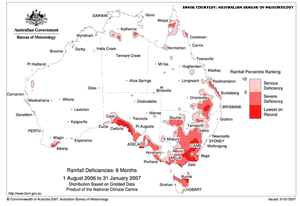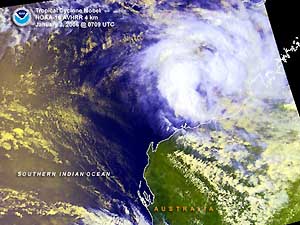Global Analysis / Global Hazards / United States / U.S.
Drought / Extremes
Use these links to access detailed analyses of Global and U.S. data.

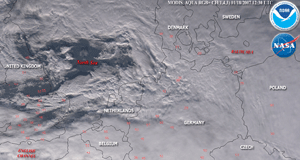
European Storm
|
Global Hazards And Significant Events
January 2007
A powerful storm moving eastward from the North Atlantic impacted northern Europe during mid-January with powerful winds and heavy rainfall, causing considerable loss of life. Additional information can be found below.
|
 Drought & Heat | Flooding | Storms | Tropical Cyclones | Extratropical Cyclones | Severe Winter Weather
Drought & Heat | Flooding | Storms | Tropical Cyclones | Extratropical Cyclones | Severe Winter Weather


Across the United States, extreme drought conditions were observed in areas of Wyoming and Nebraska, as well as northern Minnesota and parts of Texas. Exceptional drought was limited to areas of south Texas. |
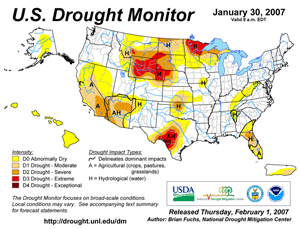
U.S. Drought Monitor
|


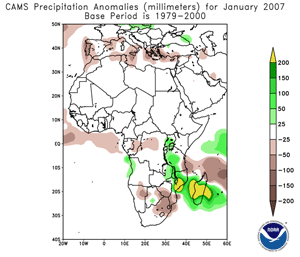
Africa Precipitation Anomalies
|
Although monthly totals were near average, excessive daily rainfall in portions of Kenya and Somalia destroyed property and crops, killed livestock, displaced people and caused fatalities. Rift Valley Fever broke out in sections of Kenya and Somalia killing at least 169 people (UN News Service). In Zambia, flooding from heavy rain in the Solwezi and Mpulungu districts affected over 100,000 people (IFRC).
|
In Angola, heavy rainfall during January 21-24 produced flooding that caused at least 81 deaths (AFP). In Mozambique, flooding rains rendered more than 3,500 homeless during the 20th-23rd (AFP).
|
Heavy rainfall continued in Malaysia during early January, with the number of fatalities at 18 since flooding rains began in December 2006. The flooding was concentrated in the states of Johor and Sabah. The recent flash flooding, described as the worst in decades, was blamed in large part on environmental degradation and poor development planning. At the peak of the flooding, around 110,000 people were sheltering in relief centers (AFP). |
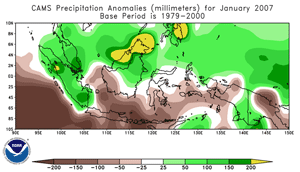
Indonesia/Malaysia Rainfall Anomalies
|
In northeastern Indonesia, a landslide triggered by floodwaters killed 11 people and left 21 others missing. At least 64 houses and two churches were swept away on the remote Sangihe Island (Associated Press). |
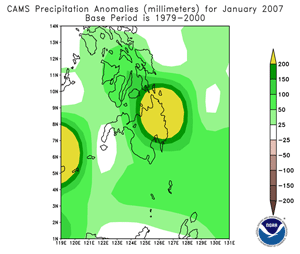
Philippines Rainfall Anomalies
|
In the Philippines, heavy rainfall produced flooding and landslides during the first two weeks of January that killed 23 people and displaced nearly 25,000 people. Seventeen people were killed in Samar and southern Leyte provinces, while six fatalities were reported in Agusan province (AFP).
|
Monsoon-related flash flooding in Sri Lanka killed 14 people and rendered another 61,000 homeless in January (AFP). |
In Brazil, heavy rains in the southeastern part of the country resulted in 31 deaths from flooding and mudslides during the first week of January. The majority of the fatalities occurred in the Rio de Janeiro state (Associated Press).
|
On the 11th, heavy rainfall led to a dam collapse at a mining company in Brazil's Minas Gerais state, releasing about 2 billion liters (530 million gallons) of mud, bauxite and aluminum sulfate into rivers that supply water for around 90,000 people. In the city of Muriae (located about 318 km northeast of Rio de Janeiro), the polluted water covered houses, killed fish and left a muddy mark two meters (~7 feet) high on city buildings (see photo) (Associated Press). |
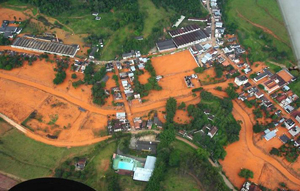
Flooding in Muriae, Brazil
|
In Peru, heavy rainfall since late December 2006 produced flooding in the Departments of San Martin and Huanuco in northeast Peru, causing the Huallaga River to exceed the flood stage. More than 30,000 people were affected, with significant damage to crops/agriculture (OCHA). In neighboring Bolivia, several thousand families were affected by flooding during the month (OCHA).
|
In Bolivia, heavy rainfall produced flooding along the major rivers of the country, including the Rio Grande, Pilcomayo, San Juan del Oro, and Bermejo. At least 40,000 people were affected (OCHA).
|


In the United States, severe thunderstorms generated tornadoes along the central Gulf Coast region on January 4. In Lousiana's Iberia Parish, there were 2 deaths and at least 15 injuries. As many as ten homes were destroyed (Associated Press). |
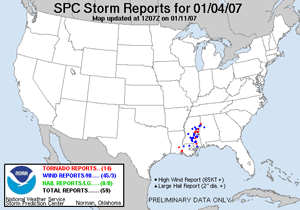
U.S. Severe Weather Reports
|


Tropical Cyclone Clovis developed in the southern Indian Ocean on December 31 and made landfall along the east coast of Madagascar on January 3 with maximum sustained winds near 120 km/hr (65 knots or 75 mph). After heavy rainfall from the passage of a cold front as well as Tropical Cyclone Bondo in December 2006, flooding and mudslides were the primary effects from Clovis. |
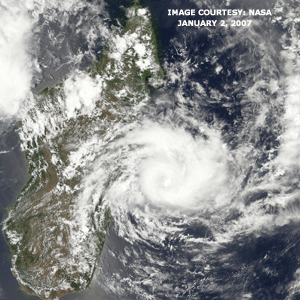
Tropical Cyclone Clovis
|


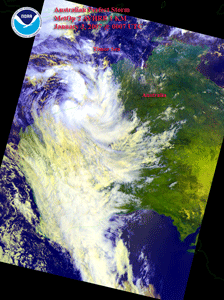
Australian "Perfect Storm"
|
The remnants of Tropical Cyclone Isobel merged with a non-tropical low-pressure system to create a very large and uncharacteristically powerful storm system across Western Australia on the 4th. The storm's evolution drew parallels with the "Perfect Storm" in the North Atlantic Ocean during October 1991. Very heavy rain was reported in southern sections of Western Australia, with 135 mm (5.3 inches) at Esperance along with winds gusting to 72 km/hr (45 mph) (BBC News).
|
A powerful storm system affected much of northern Europe during the 17th-18th. Torrential rains and winds gusting up to 170 km/hr (105 mph) affected portions of southern Britain, northern France, the Netherlands, Germany, and the Czech Republic. The UK Met Office reported the strongest winds since January 1990 across the country. There were at least 47 deaths across the region, with tens of thousands losing electrical services during the storm (AFP). |

European Storm
|


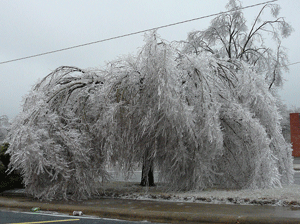
Muskogee, OK Ice Storm Photo
|
Ice and snow affected large sections of the United States during January 12-17, from Texas and Oklahoma northward through Missouri, Illinois and northeastward into New England. There were more than 60 fatalities, and hundreds of thousands of residents lost electricity to their homes and businesses (AFP). In Oklahoma alone, 23 people lost their lives (Reuters).
|
Subfreezing temperatures and snow occurred unusually far to the south in parts of Southern California. Governor Arnold Schwarzenegger warned that California's fruit industry was facing its worst-ever crisis due to prolonged low temperatures. Preliminary agricultural losses were estimated at $1 billion (USD)(AFP). In Phoenix, Arizona, low temperatures dipped to -2°C (29°F) on both the 14th and 15th. Previously, the last subfreezing temperature was observed on December 23, 1990. |
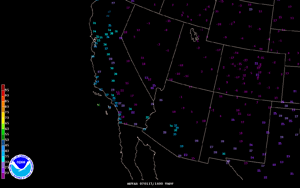
U.S. Southwest Temperatures on January 17
|
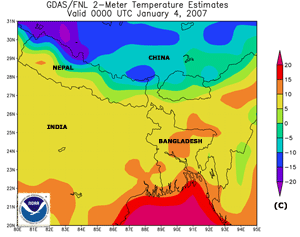
India/Bangladesh Temperatures on January 4
|
In Bangladesh in early January, unusually cold weather affected northern districts of the country, producing temperatures as low as 5°C (41°F), or reportedly the coldest in 38 years. At least 130 fatalities resulted from the cold weather, as well as adverse impacts on winter crops. (OCHA)
|

For all climate questions other than questions concerning this report,
please contact the National Climatic Data Center's Climate Services
Division:
- Climate Services Division
NOAA/National Climatic Data Center
151 Patton Avenue, Room 120
Asheville, NC 28801-5001
fax: 828-271-4876
phone: 828-271-4800
email: ncdc.orders@noaa.gov
|

For further information on the historical climate perspective presented in this report, contact:
- Scott Stephens
NOAA/National Climatic Data Center
151 Patton Avenue
Asheville, NC 28801-5001
fax: 828-271-4328
email: Scott.Stephens@noaa.gov
|
|







